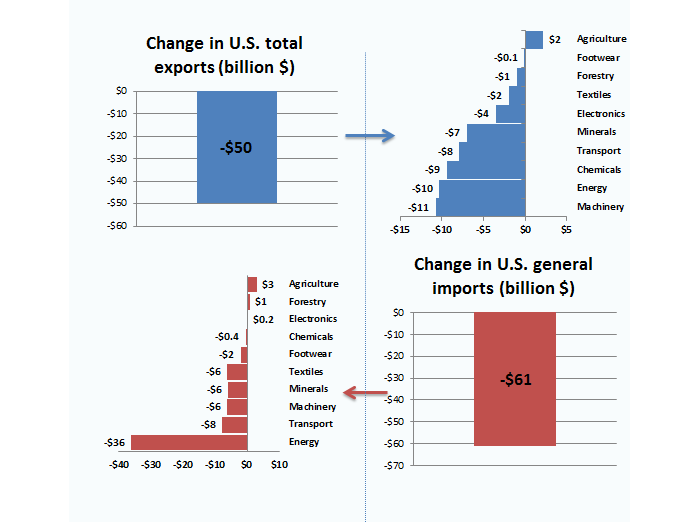Shifts in U.S. Merchandise Trade, 2016
Investigation No. 332-345
Publication 4723 (September 2017)
Welcome to Shifts in U.S. Merchandise Trade, 2016 (also called 2016 Trade Shifts), published by the U.S. International Trade Commission (Commission or USITC). This year’s report is again web-based and enhanced by interactive features but only presents interactive graphics and tables without analysis for 8 U.S. trading partners/regions and 10 sectors. The analytic text that normally accompanies these data will not be provided this year, due to competing resource demands generated by high workloads in other areas of the Commission’s mission. We hope to resume providing such analysis in next year’s report.
As in last year’s report, a variety of methods are used to measure trade in 2016 Trade Shifts to allow a more inclusive look at the composition of U.S. trade flows. Data for total exports ![]() are presented in the report’s first two parts. The first part shows data on sectoral trade flows in the U.S. economy in 2015–16, while the second part provides data addressing U.S. bilateral trade flows with three individual trading partners (Canada, Mexico, and China), four regions (the European Union 28 (EU-28), Asia, the Organization of Petroleum Exporting Countries (OPEC), and sub-Saharan Africa (SSA)), and under the North American Free Trade Agreement (NAFTA) as a whole. A complete list of the partners in the above groups is in our "How are partner/regional groups defined?." The third part of the report presents data on the following trade flows—general imports, domestic exports
are presented in the report’s first two parts. The first part shows data on sectoral trade flows in the U.S. economy in 2015–16, while the second part provides data addressing U.S. bilateral trade flows with three individual trading partners (Canada, Mexico, and China), four regions (the European Union 28 (EU-28), Asia, the Organization of Petroleum Exporting Countries (OPEC), and sub-Saharan Africa (SSA)), and under the North American Free Trade Agreement (NAFTA) as a whole. A complete list of the partners in the above groups is in our "How are partner/regional groups defined?." The third part of the report presents data on the following trade flows—general imports, domestic exports  , and re-exports
, and re-exports  — for 10 sectors.
— for 10 sectors.
Like last year’s report, 2016 Trade Shifts is published only in a web-based format to optimize the use of interactive features. User-friendly, in-line interactive graphics appear at the top of each trading partner/region and sector webpage followed by the appropriate tables for each. Viewers can change the data presentation in any graphic by hovering their cursors over the graphic.
We appreciate feedback. Please email comments to TradeShifts@usitc.gov.
Contents
2016 Trade Shifts reviews U.S. trade performance in 2016. It focuses on changes in:
- U.S. exports and imports of key natural resources, as well as products of leading agricultural and manufacturing industries;
- U.S. trade with eight key partners and country groups; and
- Ten major U.S. sectors that cover a majority of the products traded.
Readers can access the different sections of the study, including a complete set of trade tables and “Frequently Asked Questions” (FAQs), by following the live links on this 2016 Trade Shifts home page. Alternatively, readers can always navigate to links in the “Trade Shifts 2016 Index” or “Trade Shifts 2016 Resources” boxes at the top left of each page. Below is an infographic briefly showing the principal developments in U.S. trade during the past year, followed by links to the individual webpages.
Frequently Asked Questions (FAQs)
Key Economic Events
For the 10 sectors covered in this report:
|
 |
|
Of the 10 sectors covered:
|
Part II: Country Shifts
Part II presents information on trade between the United States and eight key trading partners/regions:
Canada
China
Mexico
Asia
European Union 28 (EU-28)
North American Free Trade Agreement (NAFTA)
Organization of Petroleum Exporting Countries (OPEC)
Sub-Saharan Africa (SSA)
A complete list of the partners in the above groups is in our "How are partner/regional groups defined?"
Part III: Sector Shifts
Part III presents information on trade for the following 10 merchandise sectors:
Agricultural Products
Chemicals and Related Products
Electronic Products
Energy and Related Products
Footwear
Forest Products
Machinery
Minerals and Metals
Textiles and Apparel
Transportation Equipment
General Contacts
Office of Industries
Tradeshifts@usitc.gov
Elizabeth R. Nesbitt
Project Leader
Media Contact
Peg O’Laughlin
Public Affairs Officer
202-205-1819
